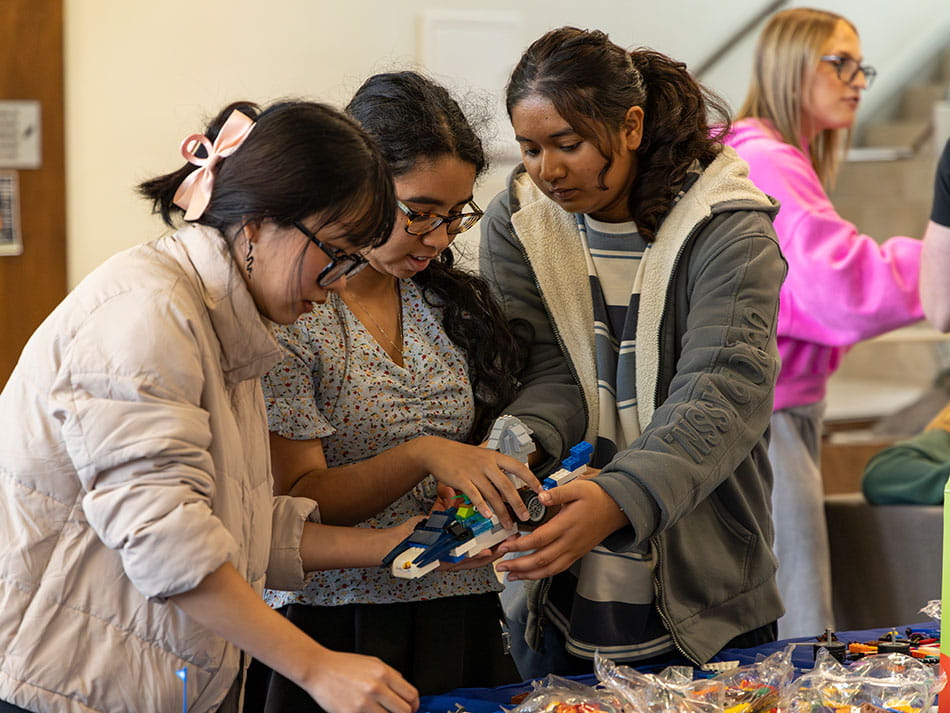Teleportation. Solar power. Amphibious capabilities.
Those were a few of the innovative student projects proposed at the “LEGO-esque” competition (not all of the bricks were LEGO brand), held in the lobby of the Gerrish School of Business and sponsored by the Colin and Erika Angle Center for Entrepreneurship.
Guided by the theme of “the future of transportation,” students were challenged with coming up with original means of travel in the future. The cross-disciplinary event, held on Oct. 17, included teams of up to five members from at least two different academic departments to promote collaboration across majors.
“We didn’t want to have whole teams of business majors or engineering majors,” explained Grace Kolis ’24 M’25, a graduate assistant at the Angle Center and an MBA candidate at Endicott. “We wanted to foster the creative thinking that comes with having people from different disciplines. The goal of this competition was to remind students that entrepreneurship isn’t confined to business majors; it’s a mindset that empowers every student to innovate and solve real-world problems.”
That approach worked, as students studying marketing, entrepreneurship, business management, finance, studio art, psychology, sport management, interior architecture, and computer science joined the fun. To start, 19 students representing five teams were given four hours and a box containing 1,000 basic building blocks. Once their ideas accelerated, the teams were able to select from a large collection of more unusual pieces to help establish the distinct design features of each proposed vehicle.
Entrepreneurship majors Aidan Russell ’25 and Parker Bradlee ’28 teamed up with marketing majors Iliana Rodriguez ’26 and Michael DeLorenzo ’26 to create a LEGO teleportation station that proposed to reuse the infrastructure of old train stations to allow for worldwide teleport hubs. The group asserted that reusing railroad infrastructure offered a sustainable and efficient option, reducing construction costs and minimizing environmental impact.

“Whether for daily commutes, leisure trips, or emergencies,” the group project description reads, “EcoPort offers a transformative way to move through cities and across the globe.”
Russell said the group was inspired to think about how to reuse existing modes of public transport to represent the future of transportation as an experience.
“This competition pushed people to be creative and share their big ideas with limited resources and time,” said Russell, who aspires to start his own business one day, “all while working in groups to ensure that we were able to show off our ideas for the future within the time limit.”
With their “EcoPort” project, Russell and teammates were named co-winners of the competition, sharing the $1,000 grand prize with the team of Quinn O’Connor ’28, Luke Laplante ’28, and Alec Zagami ’28, who built a public transportation vehicle based on a dual-energy system that harnesses both hydroelectric and solar power.
“It hovers by using electromagnets under the wheels,” explained O’Connor, an entrepreneurship major. “We worked as a team, creating and innovating on different parts of the vehicle to make a better whole. We also problem-solved a great deal by finding ways around issues, mostly with not having the right pieces.”
The second-place team of Braydon Lockhart ’28, Oliver Reall ’28, Chase McCarthy ’28, Ben Ryder ’28, and Sam Ryder ’28 created a futuristic solar-powered propeller (“The Wave”) that would be affixed to the roof of a car, allowing it to fly. The LEGO-based model was built using Endicott colors, “because it represents who we are as a school and what happens when we work together.”

Inspired by sharks, one of nature’s most efficient aquatic creatures, the three members of the third-place team, Sarah Chan ’25, Keo Son ’28, and Raseda Be ’28, developed “Sharky the Submarine Car,” a hybrid amphibious vehicle that drives on land and underwater without restriction.
In their project description, the team members referenced rising sea levels and the need for flexible transportation, especially in coastal cities impacted by climate change. The imaginative design considered waterproofing and proposed a propulsion system able to adapt to wet and dry environments. The group also incorporated its members’ diverse majors into its collaboration.
“Our amphibious cars,” they wrote, “combine computer science, art, and business skills to show how multidisciplinary methods promote innovation.”
A fifth group, consisting of Sajeela Shahid ’26, Madison Snyder ’26, Kristina Wright ’27, and Morgan Mooskian ’27, earned the “fan favorite” award for its “Gull and Go” station, designed to replace ride-share drivers with autonomous vehicles. All of the student creations impressed judges Cher Herrington, an assistant professor and internship coordinator for experiential learning, and Lisa Freed, an adjunct professor who teaches an innovation seminar.
Kolis said she was pleasantly surprised not only by the students’ ingenuity but also their building skills. Their prototype vehicles, she noted, looked like they were ready for action.

While the Angle Center hosts events to encourage students to think creatively, most notably the annual Spark Tank competition, Kolis credits Executive Director Gina Deschamps with originating the idea for the LEGO-esque competition. The goals of the event were to encourage innovation, team-building, and problem-solving skills across disciplines, while trying something new.
“This competition captures what the Angle Center is all about,” Kolis said. “Giving students a chance to dive into entrepreneurial experiences, work across different disciplines, and build a stronger culture of creativity and problem-solving at Endicott.”


